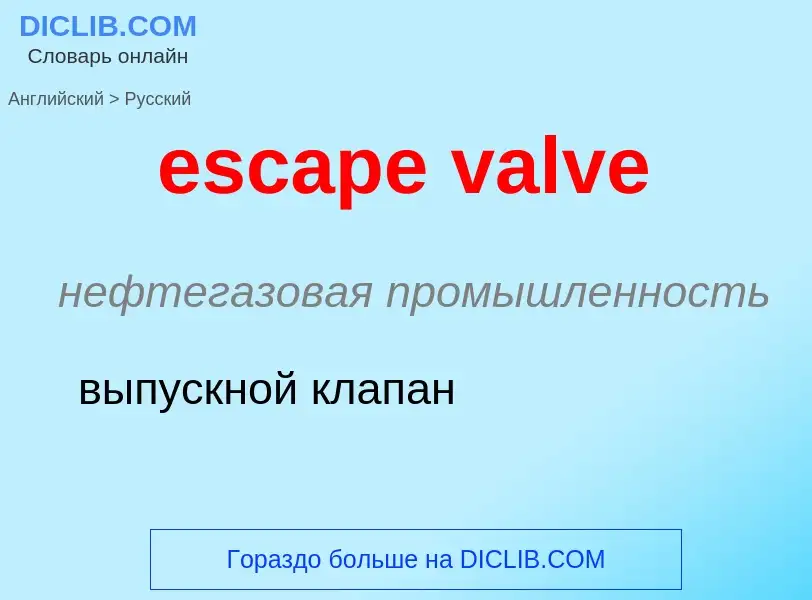Перевод и анализ слов искусственным интеллектом ChatGPT
На этой странице Вы можете получить подробный анализ слова или словосочетания, произведенный с помощью лучшей на сегодняшний день технологии искусственного интеллекта:
- как употребляется слово
- частота употребления
- используется оно чаще в устной или письменной речи
- варианты перевода слова
- примеры употребления (несколько фраз с переводом)
- этимология
escape valve - перевод на русский
нефтегазовая промышленность
выпускной клапан
общая лексика
бегство
поведение
связанное с уходом от опасности
общая лексика
реакция бегства
реакция избегания
[vælv]
общая лексика
вентиль
вентильный
задвижка
затвор
золотник
золотниковый
клапанный
кран
пневмоаппарат
электронная лампа
ботаника
вальва
створка
анатомия
клапан
медицина
заслонка
строительное дело
вентиль, задвижка, шибер
нефтегазовая промышленность
распределительный кран
подавать через клапан
существительное
общая лексика
клапан (на духовых инструментах)
клапан, вентиль
ламповый
клапанный
ботаника
вальва
створка
техника
клапан
вентиль
золотник
задвижка
заслонка
электроника
электронная лампа
музыка
пистон, вентиль
Википедия
A helium release valve, helium escape valve or gas escape valve is a feature found on some diving watches intended for saturation diving using helium based breathing gas.
When saturation divers operate at great depths, they live under pressure in a saturation habitat with an atmosphere containing helium or hydrogen. Since helium atoms are the smallest natural gas particles, they are able to diffuse into the watch, past the seals which are able to prevent ingress of larger molecules such as water. This is not a problem as long as the watch remains under external pressure, but when decompressing, a pressure difference builds up between the trapped gas inside the watch case and the environment. Depending on the construction of the watch case and crystal, this effect can cause damage to the watch, such as the crystal popping off, as diving watches are designed primarily to withstand external pressure.
Some watch manufacturers manage this effect by simply making the case strong enough to withstand the internal pressure, but Rolex and Doxa S.A. approached the problem by creating the helium escape valve in the 1960s (first introduced in the Rolex Submariner/Sea-Dweller and the Doxa Conquistador): A small, spring-loaded one-way valve is fitted in the watch case that opens when the differential between internal and external pressure reaches is sufficient to overcome the spring force. As a result, the valve releases the gases trapped inside the watch case during decompression, preventing damage to the watch. The original idea for using a one-way valve came from Robert A. Barth, a US Navy diver who pioneered saturation diving during the US Navy Genesis and SEALAB missions led by Dr. George F. Bond.
Automatic helium release valves usually don't need any manual operation, but some are backed up by a screw-down crown in the side of the watch, which is unscrewed at the start of decompression to allow the valve to operate.
Helium release valves can primarily be found on diving watches featuring a water resistance rating greater than 300 m (1000 ft). ISO 6425 defines a diver's watch for mixed-gas diving as: A watch required to be resistant during diving in water to a depth of at least 100 m and to be unaffected by the overpressure of the breathing gas. Models that feature a helium release valve include most of the Omega Seamaster series, Rolex Sea Dweller, Tudor watches Pelagos, some dive watches from the Citizen Watch Co., Ltd, Breitling, Girard-Perregaux, Anonimo, Panerai, Mühle Rasmus by Nautische Instrumente Mühle Glashütte, Deep Blue , all watches produced by Enzo Mechana, Aegir Watches and selected Doxa, selected Victorinox models, Oris models, TAG Heuer Aquaracer models, and the DEL MAR Professional Dive 1000 watch. Other watch manufacturers such as Seiko and Citizen Watch Co., Ltd still offer high-level dive watches that are guaranteed safe against the effects of mixed-gas diving without needing an additional opening in the case in the form of a release valve. This is normally achieved through the use of special gaskets and monocoque case construction instead of using the more common screw down case-backs.

![An integrated, automatically operating helium release valve as used by Rolex for their latest version of the [[Rolex Sea-Dweller]], the Deepsea. An integrated, automatically operating helium release valve as used by Rolex for their latest version of the [[Rolex Sea-Dweller]], the Deepsea.](https://commons.wikimedia.org/wiki/Special:FilePath/he_release_valve_seadweller.jpg?width=200)
![Breitling]] for the Avenger Seawolf. Breitling]] for the Avenger Seawolf.](https://commons.wikimedia.org/wiki/Special:FilePath/Breitling avenger seawolf.jpg?width=200)
![A manually operated (screw crown principle) helium release valve as used by [[Omega SA]] for their Seamaster dive watches, here the Planet Ocean. A manually operated (screw crown principle) helium release valve as used by [[Omega SA]] for their Seamaster dive watches, here the Planet Ocean.](https://commons.wikimedia.org/wiki/Special:FilePath/He_release_valve_seamaster.jpg?width=200)
![A manually operated helium release valve as used by [[Enzo Mechana]] for their entire line of dive watches. Pictured is the EM001 "Sub Hatch" A manually operated helium release valve as used by [[Enzo Mechana]] for their entire line of dive watches. Pictured is the EM001 "Sub Hatch"](https://commons.wikimedia.org/wiki/Special:FilePath/Enzo_HRV.jpg?width=200)

.jpg?width=200)

![[[Gabe Newell]] (foreground) and Doug Lombardi (background), 2007 [[Gabe Newell]] (foreground) and Doug Lombardi (background), 2007](https://commons.wikimedia.org/wiki/Special:FilePath/Gabe newell doug lombardi.jpg?width=200)
![Robin Walker]] at Steam Dev Days 2014 Robin Walker]] at Steam Dev Days 2014](https://commons.wikimedia.org/wiki/Special:FilePath/Robin Walker 3.jpg?width=200)
![[[Globe valve]] [[Globe valve]]](https://commons.wikimedia.org/wiki/Special:FilePath/Globe valve (rendered).jpg?width=200)
![A valve controlled by a [[wheel]] (on vertical line) A valve controlled by a [[wheel]] (on vertical line)](https://commons.wikimedia.org/wiki/Special:FilePath/Green tubes and valves.jpg?width=200)
![Large [[butterfly valve]] Large [[butterfly valve]]](https://commons.wikimedia.org/wiki/Special:FilePath/Nasa-space-18408-l.jpg?width=200)
![Cast iron [[butterfly valve]] Cast iron [[butterfly valve]]](https://commons.wikimedia.org/wiki/Special:FilePath/Bidirectional tight butterfly valve-The-Alloy-Valve-Stockist.jpg?width=200)
![Hastelloy [[ball valve]] Hastelloy [[ball valve]]](https://commons.wikimedia.org/wiki/Special:FilePath/Hastelloy Ball valve.jpg?width=200)
![Stainless steel [[gate valve]] Stainless steel [[gate valve]]](https://commons.wikimedia.org/wiki/Special:FilePath/Valve.jpg?width=200)
![Inside view of a tilting disc inconel [[check valve]] Inside view of a tilting disc inconel [[check valve]]](https://commons.wikimedia.org/wiki/Special:FilePath/Inside-tilting-disc-check-valve-The-Alloy-Valve-Stockist.jpg?width=200)
![Large carbon steel swing [[check valve]] Large carbon steel swing [[check valve]]](https://commons.wikimedia.org/wiki/Special:FilePath/Large-swing-check-valve-The-Alloy-Valve-Stockist.jpg?width=200)
![Disc for an alloy [[check valve]] also known as axial check valve Disc for an alloy [[check valve]] also known as axial check valve](https://commons.wikimedia.org/wiki/Special:FilePath/Nozzle-check-valve-disc-The-Alloy-Valve-Stockist.jpg?width=200)
![Balls for alloy [[ball valve]]s Balls for alloy [[ball valve]]s](https://commons.wikimedia.org/wiki/Special:FilePath/Valve-balls-The-Alloy-Valve-Stockist.jpg?width=200)

![Ball for a titanium [[ball valve]] Ball for a titanium [[ball valve]]](https://commons.wikimedia.org/wiki/Special:FilePath/Ball-valve-ball-The-Alloy-Valve-Stockist.jpg?width=200)

